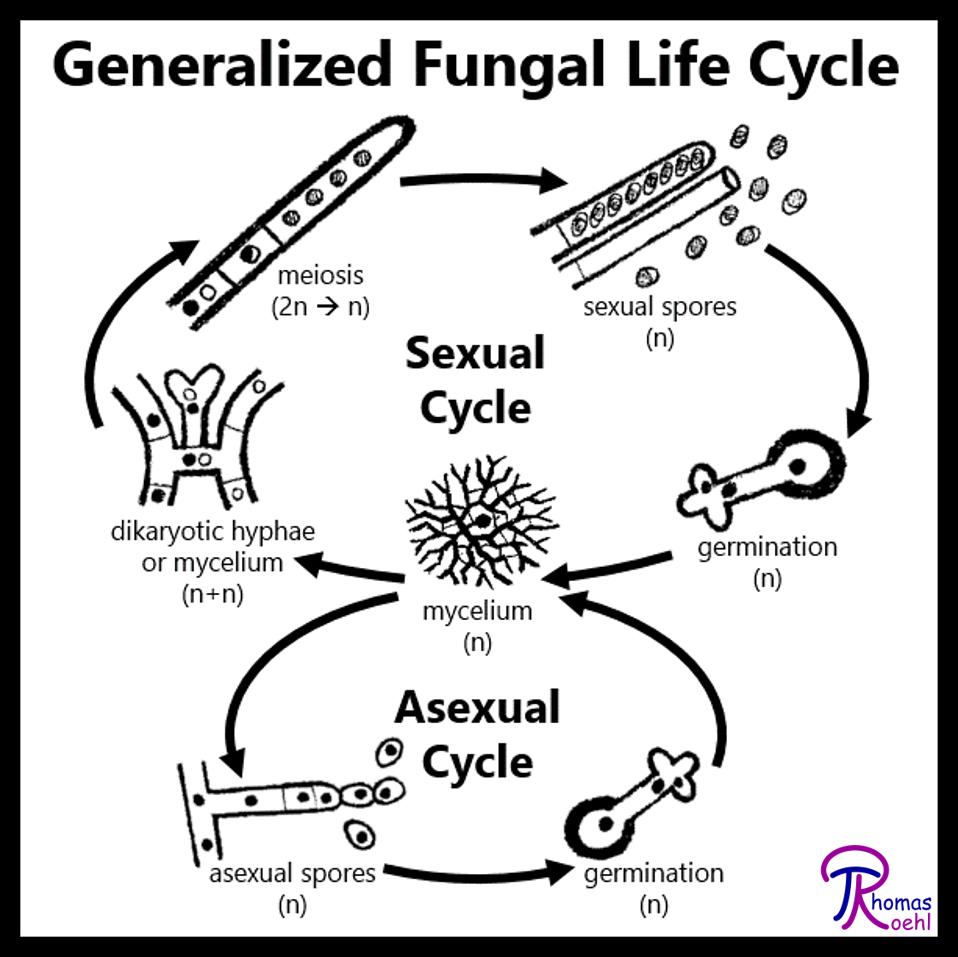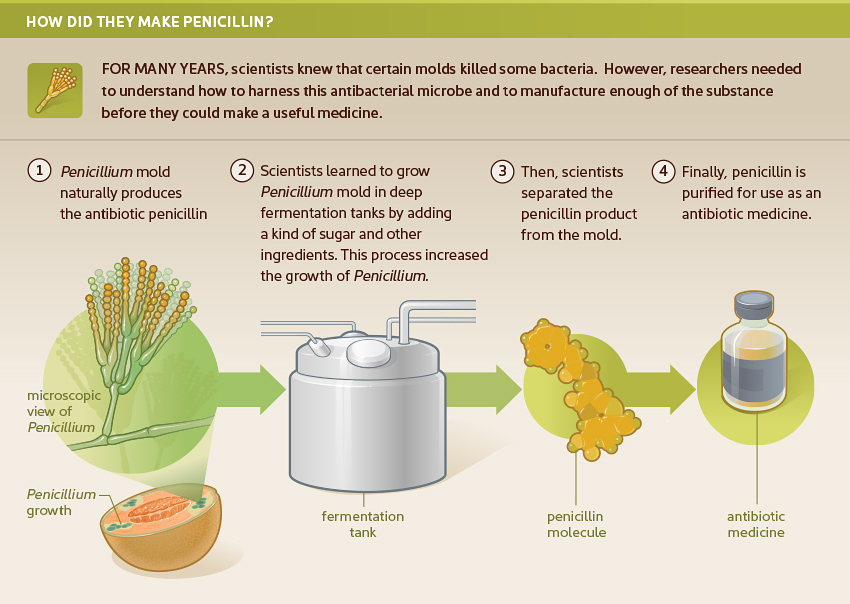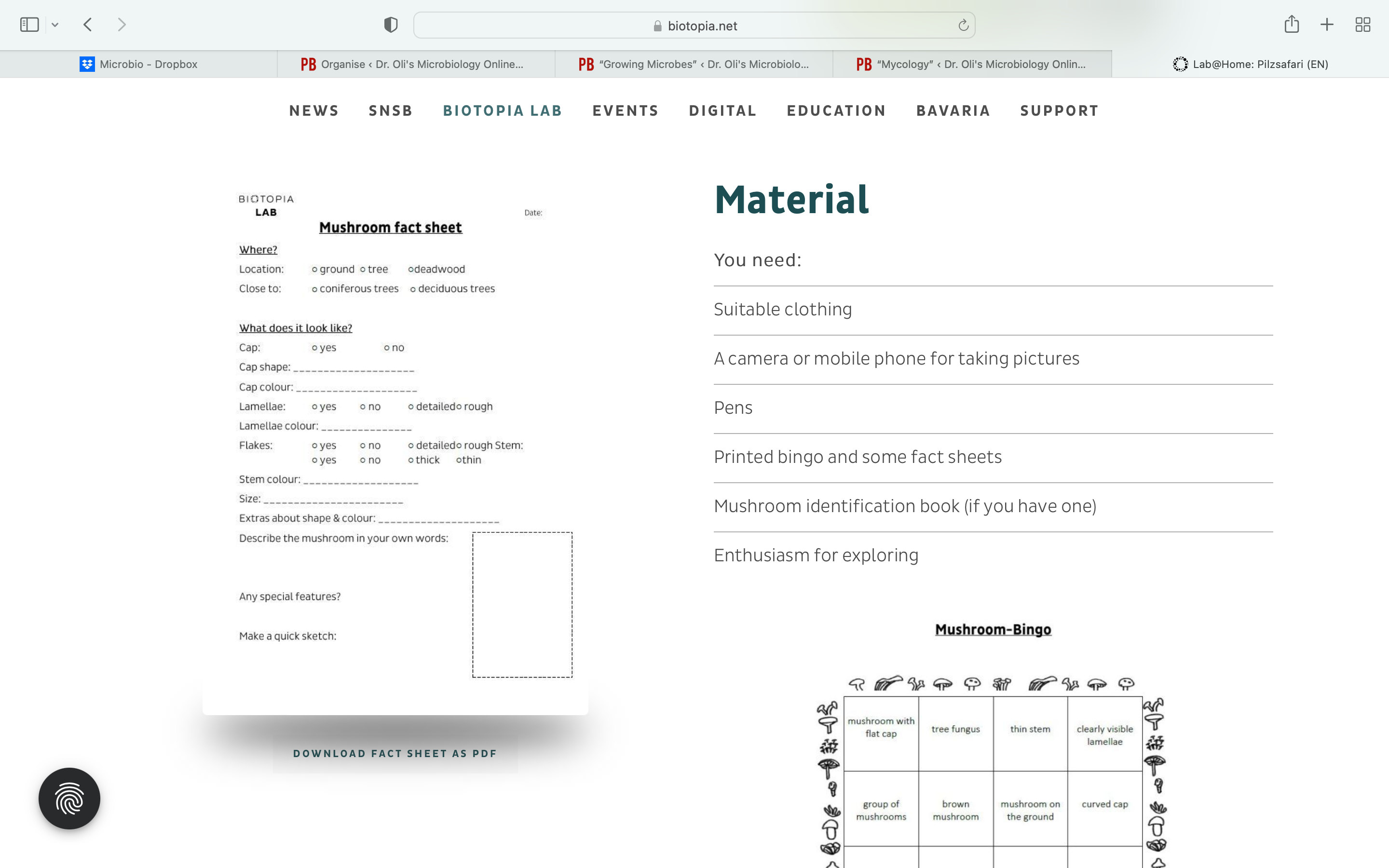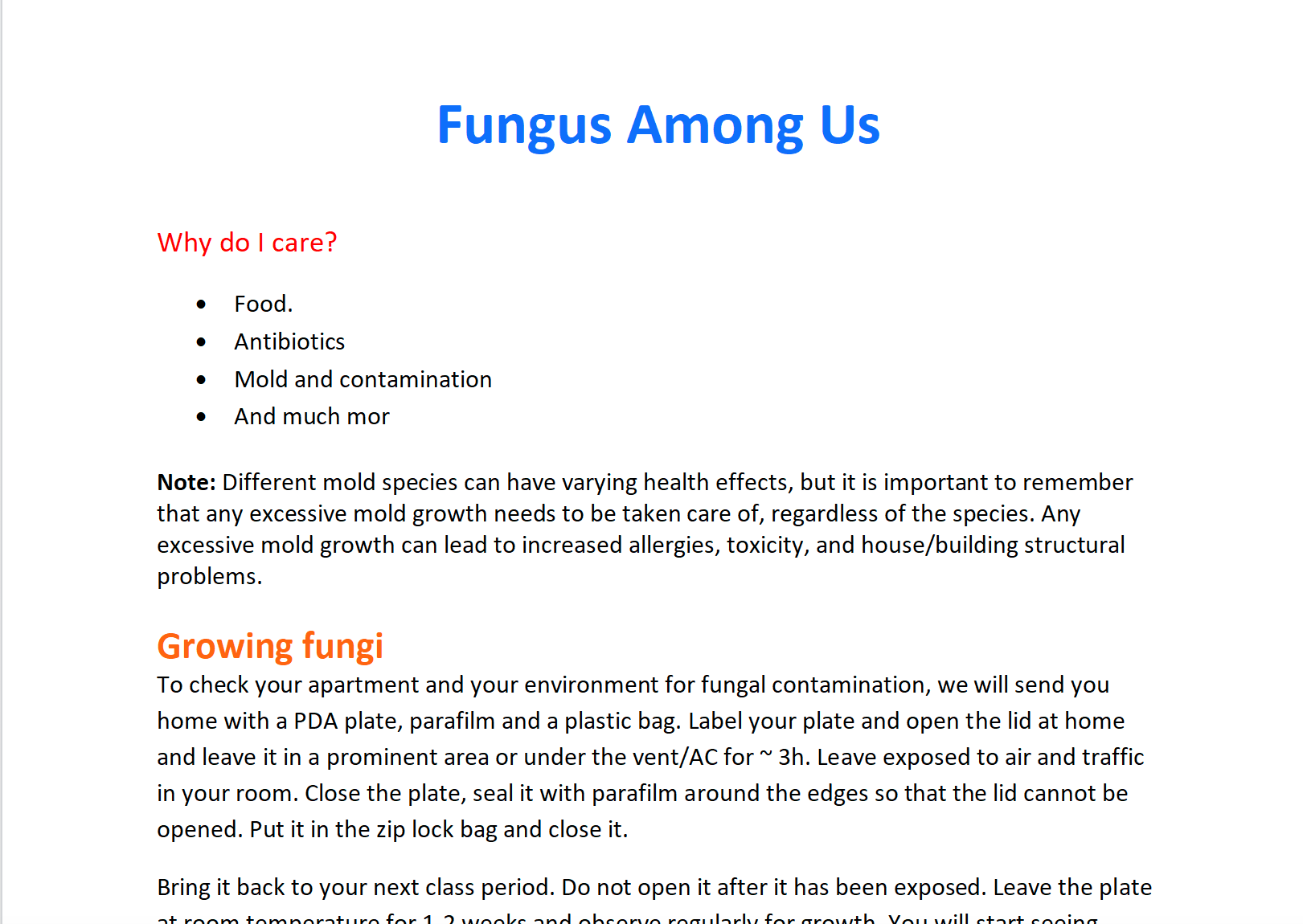Modules – Skills & Tools
Mycology
Background Information
WHY YOU SHOULD CARE ABOUT… Mycology
What do you think of when you hear the word “fungus/fungi”? Perhaps mushrooms in the forest, the process of baking bread, brewing beer, or even the discovery of penicillin when it was first isolated from mold. Some may even think of “magic mushrooms”. While these are all valid associations, the kingdom of fungi is far more diverse than most people realize and they continue to surprise us with their complex biology and adaptability.
The importance of fungi is often neglected and overlooked, often times due to the lack of awareness, their negative perceptions, and biological complexity, yet they make significant impacts on our daily lives. This list highlights the key functions of fungi and underscores the importance of understanding the fundamentals of mycology:
1) What are Fungi?
Fungi are a kingdom of eukaryotic organisms distinct from plants, animals, and bacteria. They include a vast variety of species such as single celled yeasts, filamentous molds, and much more. Unlike autotrophic plants, fungi tend to be heterotrophic as they obtain their nutrients by breaking down organic matter or by forming symbiotic relationships with other organisms.
Key Characteristics of Fungi
- Eukaryotic.
- Cell walls are made of chitin.
- Heterotrophic.
- Opportunistic.
- Reproduce sexually/asexually through spores and asexually through hyphae.
- Can exist as microscopic yeasts (unicellular), filamentous fungi (ex. molds), and macroscopically as mushrooms (the fruiting body of the fungi).
- Some fungi be dimorphic (can alternate between being a yeast or filamentous) depending on environmental factors.
Life Cycle
The life cycle of fungi can vary depending on the type of fungi and the environment they’re in. For instance, the different species of Ophiocordyceps are highly specialized and therefore only parasitize specific types of insects (Ex. O. diptigenera only infects flies, O. unilateralis infects ants but shows preference for certain species within the tribe Camponotini). On the other hand, some fungi are more generalist and can grow on various substrates and hosts (Ex. aspergillus grows on wood, leaves, the human body, food, etc., B. bassiana grows on various insect hosts, soil, plants, as well in various types of organic matter). There are even some unique cases where two different hosts are required to complete the life cycle like Puccinia graminis! Its important to note that fungi can reproduce asexually and sexually depending on the environmental circumstances.
For practicality, we will be focusing on a generalized fungal life cycle:

Taxonomy
The taxonomy of fungi is complex and continually evolving due to advancements in molecular techniques and the ongoing reevaluation of existing data. While understanding fungal taxonomy is important for grasping the diversity and relationships within fungi, it’s essential to remember that this classification system is constantly evolving. Advances in molecular techniques and ongoing research lead to frequent updates and revisions. Therefore, instead of focusing too heavily on specific taxonomic categories, it’s more valuable to appreciate the broader concepts of fungal diversity and ecological roles. This approach allows us to adapt to new information and remain flexible in our understanding of fungal biology.
To begin, it is essential to understand the major fungal phyla, with a particular focus on Ascomycota and Basidiomycota. These two phyla are the largest and most diverse, and they are more frequently encountered in our daily lives compared to the other, albeit still significant, phyla.

2) What are the applications of Fungi in microbiology?
a) Fungi as Pioneers of Terrestrial Life
Fungi have been crucial in shaping the Earth’s ecosystems. They were among the first organisms to colonize land, transforming barren rock into fertile soil. This process, known as biological weathering, involves lichen (symbiotic relationship between fungi and algae or cyanobacteria) breaking down rocks and minerals, releasing essential nutrients that enable plant growth. Without fungi, the lush landscapes we see today would not exist. Lichens, such as Cladonia rangiferina, a symbiotic partnership between fungi and algae or cyanobacteria, are perfect examples of this transformative power. They thrive in extreme environments, from volcanic rocks in Hawaii to the frozen tundra, demonstrating fungi’s adaptability and resilience.

Figure 2: Lichen on rock, illustrating an example of biological weathering. Lichen contributes to the gradual breakdown of rocks over time, showcasing the long-term process of biological weathering. Source Link.
b) Medical Contributions
Fungi have had a profound impact on medicine. The discovery of penicillin from the mold Penicillium notatum revolutionized healthcare, leading to the development of antibiotics that have saved countless lives. Beyond penicillin, fungi produce a wide range of bioactive compounds with therapeutic potential. Cyclosporine, derived from the fungus Tolypocladium inflatum, is an immunosuppressant critical for organ transplant success. Research continues to uncover new antifungal, antiviral, and anticancer agents derived from fungi, highlighting their significance in drug discovery and development.

c) Agricultural and Industrial Applications
Fungi are indispensable in food production and biotechnology. Yeasts such as Saccharomyces cerevisiae are essential for baking, brewing, and winemaking, while molds like Penicillium roqueforti play a key role in cheese production and fermentation processes. On the flip side, fungal pathogens like Botrytis cinerea, which causes gray mold in fruits and vegetables, pose significant challenges in agriculture, causing diseases that affect crops and livestock. Understanding these pathogens is crucial for developing effective strategies to protect our food supply. Additionally, fungal enzymes from Aspergillus niger are harnessed in various industries, from producing biofuels to manufacturing pharmaceuticals and textiles.
d) Environmental and Biotechnological Applications
Fungi are powerful agents of bioremediation, capable of breaking down pollutants and restoring contaminated environments. Phanerochaete chrysosporium, a white-rot fungus, can degrade lignin and a wide range of environmental pollutants, making it invaluable in cleaning up oil spills, heavy metal contamination, and other environmental pollutants. Similarly, edible oyster mushrooms (Pleurotus spp.) are being utilized to absorb and remove heavy metal pollutants from the environment. Innovative research is also exploring fungi’s potential in sustainable agriculture, bioenergy production, and even the development of biodegradable materials.
Learning Objectives:
After completing this module, students will be able to:
- Recall new vocabulary and definitions that pertain to this module.
- Differentiate how to recognize yeast and mold.
- Describe how to grow yeast and mold and how to make a lactophenol cotton blue stain.
- Examine the unique features of true slime molds (Myxomycetes).
- Describe the uniqueness of lichen.
- Name and describe 3 medically important yeast or molds.
- Explain the commercial and new applications of fungi
History Connection
Virtual Lab Simulations
Mycology Scavenger Hunt: virtual lab simulation
Online Lab
Activity: Examining Fungi Structures & Growth
1) Examining Mold Structures By Staining with Lactophenol Blue
2) Growing Fungi & Mold on your PDA Plate
Lab Kit Materials
- Glass Slides (1 box)
- Scotch Tape
- Lactophenol Blue Dropper
- 1 PDA Plate
- Sharpie
- Transfer Pipette
- Perifilm
- Self-provided: Household Fungi & Mold Samples
Video Tutorial
Staining Fungi with Lactophenol Blue
Procedures
1) Examining Mold Structures By Staining with Lactophenol Blue
- Find any household mold or fungi samples that you are interested in examining the fungal structures for. In the video tutorial, we used a sample of moldy ginger so feel free to use any moldy fruit, bread, or food samples you have around your house.
- Use your lactophenol blue dropper to add a drop of lactophenol blue to the center of a glass slide.
- Press the sticky side of the tape against your mold sample.
- Transfer the tape to the slide so that your mold sample is pressed against the lactophenol blue drop and press down against the slide.
- View your slide using your microscope and include result information in your ELN.
2) Growing Fungi & Mold on your PDA Plate
- When ready to begin the mycology module, remove your PDA plate from the refrigerator and label with your initials, media type (PDA), date, and the location where you chose to leave the plate open.
- After labeling, set your open PDA plate on a surface where it will not be disturbed and leave open for 3-4 hours.
- Close the plate, wrap it in perifilm as shown in video tutorial, and let incubate at room temperature.
- Record growth structures and fungal colonies every couple hours from 4-24 hours.
- DO NOT OPEN PLATE AFTER THERE IS GROWTH, as mold and fungi spores can become airborne and cause illness. Discard without opening plate after recording results in ELN.
Results
Include the following information in ELN:
- Growth and fungal colony characteristics at each of the following time points: 4 hours, 8 hours, 12 hours, & 24 hours.
- Why do we only work with mold and fungi samples in the hood when in the laboratory?
- What are some common examples of fungi that you see in your house and neighborhood? Include pictures of 3-5 fungal examples and attempt to identify the species using their structures.
- Discuss the different taxonomic backgrounds for fungi.
- What are mushrooms and how are they different from other types of fungi?
In-Person Lab
Fungus Among Us In- Person Procedure:
Resources
Suggested Fungal Field Guide for Our Area: Mushrooms of the Gulf Coast States
FungiJon: How to chemically ID Fungi!
Case Study
Another fascinating example of a unique fungal life cycle is found in entomopathogenic fungi, which parasitize insects. The diagram below illustrates the life cycle of Entomophthora species, a group of fungi known for infecting and ultimately killing their insect hosts. These fungi are especially interesting due to their ability to manipulate the behavior of their hosts, often driving them to climb to elevated positions before death, which aids in the widespread dispersal of fungal spores. Unlike fungi with broad-spectrum infection capabilities like Beauveria bassiana, Entomophthora species demonstrate a high degree of host specificity, typically targeting specific insect species. Understanding how these fungi operate opens the possibility of developing them as environmentally friendly biopesticides, though more research is needed to fully harness their potential.
Figure 5: Schematic illustration of the life-cycle of Entomophthora fungi.



